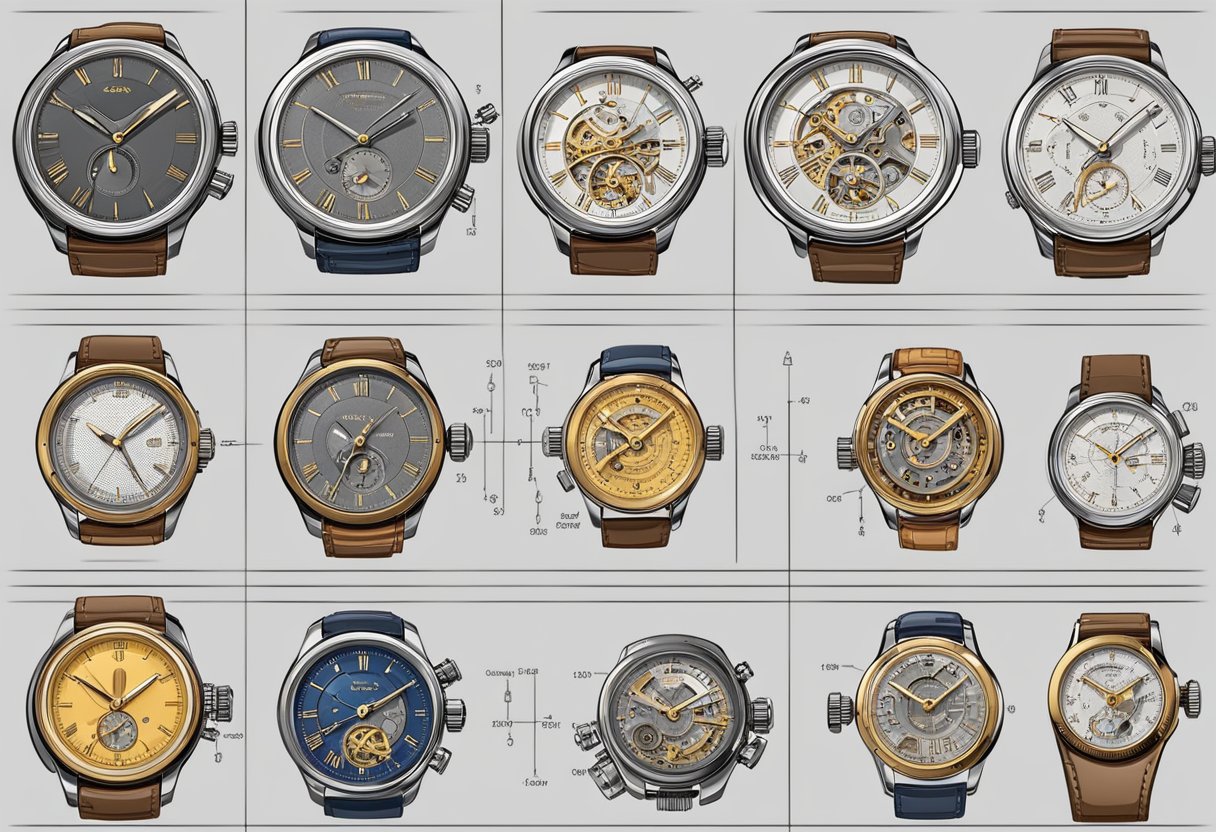Types Of Watches
Watches have been around for centuries, evolving from simple time-telling devices to stylish accessories and status symbols. Today, there are countless types of watches available on the market, each with its own unique features, functions, and designs. From mechanical watches that rely on intricate movements to quartz watches that use electronic oscillators, there is a watch for every taste and budget.
Understanding the different types of watches can be overwhelming, especially for those who are new to the world of horology. However, by learning about the various watch movements, functionalities, and design considerations, anyone can make an informed decision when selecting a watch. Whether you’re looking for a casual timepiece for everyday wear or a luxury watch for special occasions, knowing the key features and benefits of each type of watch can help you find the perfect fit.
Key Takeaways
- Watch movements are a crucial factor in selecting a watch, with mechanical, automatic, and quartz movements being the most common.
- Watches can be categorized by their functionality, such as dive watches, pilot watches, and chronographs, each with their own unique features and designs.
- Design and style considerations, such as case materials, dial colors, and strap options, can greatly impact the look and feel of a watch and should be taken into account when selecting a timepiece.
Understanding Watch Movements

Watch movements refer to the mechanism that powers the watch and keeps time. There are three main types of watch movements: quartz, mechanical, and automatic. Each type has its unique characteristics and advantages.
Quartz Movement
Quartz movements are powered by a battery and use a quartz crystal to regulate the timekeeping. The crystal vibrates at a fixed frequency, which is converted into electrical pulses that drive the watch’s hands. Quartz watches are known for their accuracy, as they lose only a few seconds per month. They are also low-maintenance, as they require a battery change every few years.
Mechanical Movement
Mechanical movements are powered by a mainspring, which is wound manually or automatically. The mainspring drives a series of gears that regulate the timekeeping and power the watch’s hands. Mechanical watches are known for their craftsmanship and longevity, as they can last for generations with proper care. They are also appreciated by watch enthusiasts for their intricate design and visible moving parts.
Automatic Movement
Automatic movements are a type of mechanical movement that winds itself automatically through the natural motion of the wearer’s wrist. The watch has a rotor that swings with the wearer’s movement, winding the mainspring and keeping the watch running. Automatic watches are popular for their convenience and low-maintenance, as they do not require manual winding or a battery change. They are also appreciated for their craftsmanship and design, as many luxury watch brands offer automatic movements in their collections.
In summary, understanding watch movements is essential for choosing the right watch for your needs. Whether you prefer the accuracy and low-maintenance of quartz, the craftsmanship and longevity of mechanical, or the convenience and design of automatic, there is a watch movement that will suit your style and preferences.
Watch Types by Functionality
When it comes to choosing a watch, functionality is a crucial factor to consider. Different watches are designed for different purposes, and it is essential to choose the right one for the job. Here are some of the most common watch types by functionality:
Dress Watches
Dress watches are designed to be elegant and sophisticated. They are typically thin and simple, with minimal complications. Dress watches are perfect for formal occasions, and they pair well with a suit or a dress. They are not designed for heavy use, and they are not water-resistant.
Dive Watches
Dive watches are designed for underwater use. They are water-resistant and can withstand the pressure of deep dives. Dive watches typically have a rotating bezel that allows divers to keep track of their dive time. They also have luminous hands and markers that make them easy to read in low light conditions.
Pilot Watches
Pilot watches, also known as aviation watches, are designed for pilots. They typically have large, easy-to-read dials and luminous hands and markers. They also have a chronograph function that allows pilots to time their flights. Pilot watches are typically water-resistant and shock-resistant.
Field Watches
Field watches are designed for outdoor use. They are typically rugged and durable, with a simple, easy-to-read design. Field watches are water-resistant and shock-resistant, and they often have a compass function. They are perfect for camping, hiking, and other outdoor activities.
Chronograph Watches
Chronograph watches are designed with a stopwatch function. They are perfect for timing events, such as races or sporting events. Chronograph watches typically have multiple sub-dials that display the time elapsed, and they often have a tachymeter function that allows users to measure speed. Chronograph watches are water-resistant and shock-resistant, and they come in a variety of styles and designs.
In conclusion, when it comes to choosing a watch, functionality is key. Dress watches, dive watches, pilot watches, field watches, and chronograph watches are just a few of the many options available. By understanding the different types of watches by functionality, you can choose the right watch for your needs.
Design and Style Considerations
When it comes to watches, there are a variety of design and style considerations to keep in mind. Whether you’re looking for a fashion watch, luxury watch, vintage watch, or casual/formal watch, there are a few key factors to consider.
Fashion Watches
Fashion watches are all about style and making a statement. They often feature bold colors, unique designs, and trendy materials. These watches are perfect for those who want to express their personal style through their accessories. Some popular fashion watch brands include Michael Kors, Fossil, and Guess.
Luxury Watches
Luxury watches are all about quality and craftsmanship. They often feature precious metals, high-end materials, and intricate designs. These watches are perfect for those who want to make a statement with their accessories. Some popular luxury watch brands include Rolex, Patek Philippe, and Cartier.
Vintage Watches
Vintage watches are all about history and nostalgia. They often feature classic designs, unique materials, and intricate craftsmanship. These watches are perfect for those who want to add a touch of old-world charm to their accessories. Some popular vintage watch brands include Omega, Longines, and Tissot.
Casual and Formal Watches
Casual and formal watches are all about versatility. They can be dressed up or down depending on the occasion. Casual watches often feature simple designs, comfortable straps, and easy-to-read numerals and markers. Formal watches often feature more intricate designs, leather straps, and Roman numerals. Some popular casual watch brands include Timex, Casio, and Seiko. Some popular formal watch brands include Bulova, Citizen, and Hamilton.
When it comes to design and style considerations, it’s important to choose a watch that not only looks good but also fits your lifestyle and personality. Whether you prefer a bold fashion watch, a high-end luxury watch, a classic vintage watch, or a versatile casual/formal watch, there’s a perfect timepiece out there for you.
Innovations in Watchmaking
As technology continues to advance, the watchmaking industry has not been left behind. Innovations in watchmaking have resulted in the creation of watches that are more accurate, reliable, durable, and functional. Here are some of the most notable innovations in watchmaking:
Smart and Hybrid Watches
Smart and hybrid watches are some of the most innovative watches on the market today. They combine traditional watchmaking with modern technology to create watches that are both functional and stylish. Smartwatches are designed to be connected to a smartphone and offer a range of features such as notifications, fitness tracking, and GPS. Hybrid watches, on the other hand, offer some of the features of a smartwatch but with a more traditional look and feel.
Kinetic Watches
Kinetic watches are powered by the movement of the wearer’s wrist. They use a rotor to generate electricity, which is stored in a rechargeable battery. Kinetic watches are more accurate than traditional mechanical watches and do not require a battery replacement.
Solar-Powered Watches
Solar-powered watches use solar cells to convert light into electricity, which is stored in a rechargeable battery. They are more environmentally friendly than traditional battery-powered watches and do not require a battery replacement.
Tactile and Touchscreen Watches
Tactile and touchscreen watches are designed to be operated by touch. Tactile watches use vibrations to provide feedback to the wearer, while touchscreen watches have a touch-sensitive display. These watches are more user-friendly than traditional watches and offer a range of features such as notifications, fitness tracking, and GPS.
In conclusion, the watchmaking industry has come a long way in terms of innovation. From hybrid and kinetic watches to solar-powered and tactile watches, there are a variety of watches to choose from that cater to different needs and preferences. Whether you are looking for a traditional or modern watch, there is a watch out there for you.
Selecting a Watch
When selecting a watch, there are several factors to consider. Here are some of the most important factors:
By Brand and Manufacturer
The brand and manufacturer of a watch are important factors to consider when selecting a watch. Some brands are known for their quality and durability, while others are known for their affordability. It is important to choose a brand and manufacturer that has a good reputation in the watch industry.
By Lifestyle and Attire
The lifestyle and attire of the wearer are also important factors to consider when selecting a watch. For example, a sports enthusiast may want a watch that is durable and can withstand the rigors of outdoor activities. On the other hand, a professional may want a watch that is sleek and stylish, and complements their attire.
By Features and Functions
The features and functions of a watch are also important factors to consider when selecting a watch. Some watches have complications such as chronographs, moon phases, and alarms, while others have basic functions such as time and date. It is important to choose a watch with features and functions that are relevant to the wearer’s needs.
In conclusion, selecting a watch requires careful consideration of several factors such as brand and manufacturer, lifestyle and attire, and features and functions. By taking these factors into account, the wearer can choose a watch that is affordable, durable, and meets their needs for precision and accuracy.






